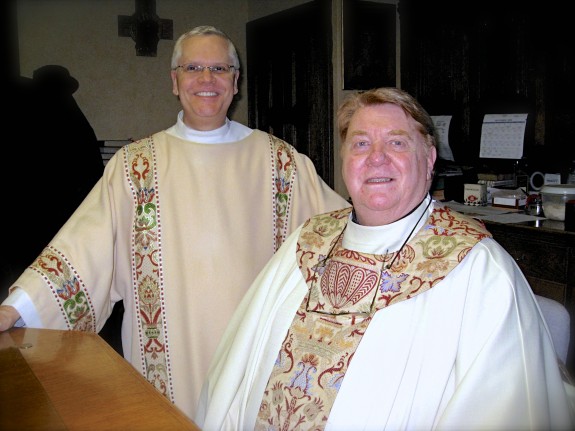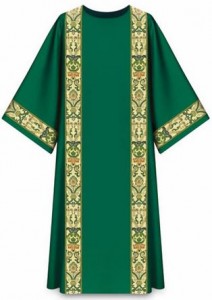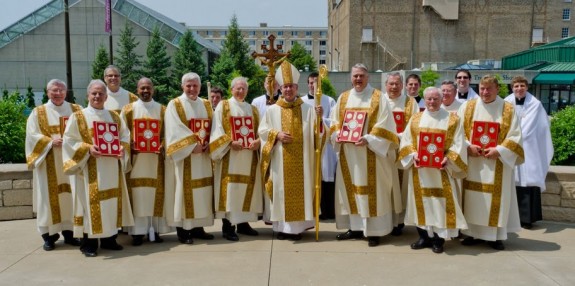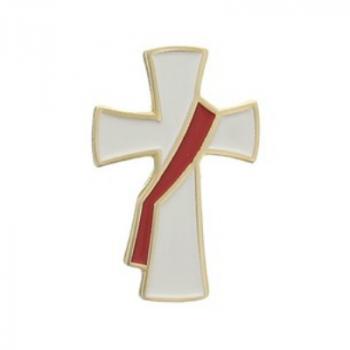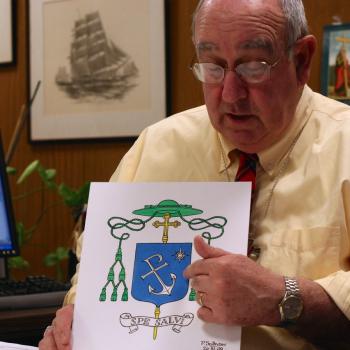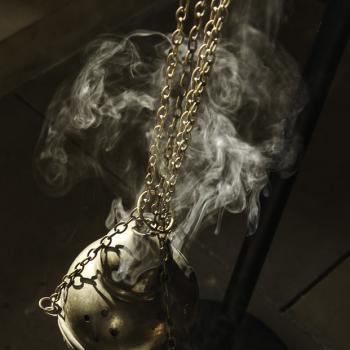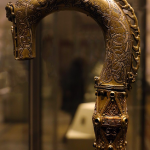Wearing the dalmatic for Midnight Mass a few years ago, with my late pastor, Msgr. Joseph Funaro.
Periodically, people ask me about that “robe” I wear during Mass. How come it has sleeves? What’s up with that??
My blog neighbor Kathy Schiffer, thankfully, has found some interesting answers, courtesy Zenit and Fr. Edward McNamara. Kathy—herself the wife of a deacon—has a (cough) vested (cough) interest in the subject.
The proper vestment for a deacon at Mass is an alb (with an amice if required), cincture, stole worn in the diaconal manner, and dalmatic. The stole and dalmatic should be of the corresponding liturgical color.
This vestment is a knee-length, sleeved garment. It was originally developed in Dalmatia, modern-day Croatia, and was imported into Rome during the second century.
At first the dalmatic, which was originally longer, reaching the heels, and more ample than today, was not well received, being seen as somewhat effeminate. Later, however, it became popular among Roman senators and imperial officials as a substitute for the toga and was even used as the proper garb for the consecration of the emperor.
From this it became a habit proper to the pope and to bishops. Finally it was introduced as a vestment for the deacons of Rome by Pope Sylvester I in the fourth century and gradually became their proper vestment. For a time, especially during the ninth to 14th centuries, bishops and even priests would sometimes wear the dalmatic under the chasuble. This use persists today, but only for bishops, who may vest a light dalmatic underneath the chasuble in solemn celebrations, especially ordinations.
According to current practice, priests celebrating according to the ordinary form never use the dalmatic. In the extraordinary form there are certain solemn celebrations in which a priest substitutes for a deacon and is vested accordingly. Likewise on exceptional occasions cardinal deacons serve the pope dressed in dalmatic.
With respect to its habitual use, we may say that the dalmatic is to the deacon what the chasuble is to the priest. Therefore, in most cases the deacon may use the dalmatic only when the priest would use the chasuble.
He has more on liturgical vestiture. Check it out.
You can find more at Wikipedia, too, which has some detailed history:
Modern dalmatics tend to be longer and have closed sleeves, with the sides being open below the sleeve. The distinctive ornamentation of the vestment consists of two vertical stripes running from the shoulder to the hem; according to Roman usage these stripes are narrow and sometimes united at the bottom by two narrow cross-stripes. Outside of Rome the vertical stripes are quite broad and the cross-piece is on the upper part of the garment. At a Pontifical High Mass, a dalmatic (usually made of lighter material) is worn by the bishop under the chasuble. At solemn papal liturgical occasions the Pope is assisted by two Cardinal-Deacons vested in a dalmatic and wearing a mitra simplex (simple white mitre).
In the Roman Catholic Church the subdeacons wore a vestment called the tunicle which was originally distinct from a dalmatic but by the 17th century the two became identical, though a tunicle was often less ornamented than a dalmatic, the main difference often being only one horizontal stripe versus the two becoming a deacon’s vestment. Additionally, unlike deacons, subdeacons do not wear a stole under their tunicle. Today, the tunicle is rare in the Roman Catholic Church as only certain authorized clerical societies (such as the Priestly Fraternity of St. Peter) have subdeacons.
Traditionally the dalmatic was not used in the Roman rite by deacons during Lent. In its place, depending on the point in the liturgy, was worn either a folded chasuble or what was called a broad stole, which represented a rolled-up chasuble. This tradition went back to a time at which the dalmatic was still considered an essential secular garment and thus not appropriate to be worn during the penitential season of Lent.
As a practical matter, I’d add a few more points:
- The deacon should always wear his stole under the dalmatic, not on the outside; wearing it on the outside, someone explained to me, is a little like wearing your underwear outside your pants.
- He should not wear the dalmatic for baptisms, unless the baptism takes place within the context of a Mass he is serving.
- As much as possible, he should wear the dalmatic every time he serves Mass, just as the priest wears a chasuble. There can be exceptions, of course; some parishes may not be able to afford dalmatics for their deacons, and there are places where the summertime heat can make too many layers unbearable (and unwearable.)

